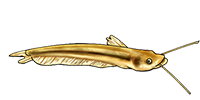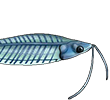| Scientific Name | Megalechis thoracata (Valenciennes, 1840) |
| Common Names | Hoplo Armoured Catfish, Gefleckter Schwielenwels (Germany), Plettet Amazon-pansermalle (Denmark), Prickig Hoplo (Sweden), Spotted Hoplo |
| Type Locality | Mana River, French Guiana. |
| Synonym(s) | Callichthys exaratus, Callichthys personatus, Hoplosternum personatus, Hoplosternum thoracatum niger, Hoplosternum thoracatum surinamensis, Hoplosternum thoracatum thoracatum, Hyplosternum thoracatum, Megalechis personata |
| Pronunciation | MEG ah LEK iss - tho rah KAT ah |
| Etymology | Megalechis: From the Greek megas, meaning large and lekis, meaning plate; in allusion to the extreme development of the coracoid bones on the breast of fully developed males. |
| Articles | |
| Size | 124mm or 4.9" SL. Find near, nearer or same sized spp. |
| Identification | Can be distinguished from the similar M. picta by the absence of a conspicuous dark vertical band in the caudal fin. In M . thoracata the caudal fin is all-over greyish. |
| Sexing | A sexually mature male exhibits a thickened first pectoral ray which ranges from orange / brown to scarlet in colour. |
| Distribution | South America: Amazon, Orinoco and upper Paraguay River basins, as well as coastal rivers of the Guianas and northern Brazil. Amazon (click on these areas to find other species found there) Orinoco (click on these areas to find other species found there) La Plata, Paraná, Paraguay, Upper Paraguay (click on these areas to find other species found there) Guyana Waters, Coastal Rivers of Guyanas (click on these areas to find other species found there) Trinidad rivers (click on these areas to find other species found there) Maranhão waters, Itapicurú (Maranhão) (click on these areas to find other species found there) Login to view the map. |
| IUCN Red List Category | Least Concern , range map and more is available on the IUCN species page. Last assessed 2020. |
| pH | 5.5 - 8.2 |
| Temperature | 17.0-28.0°C or 62.6-82.4°F (Show species within this range) |
| Other Parameters | Able to survive in poor water conditions. |
| Feeding | Not a fussy eater, most foods are accepted. Bloodworm and sinking catfish tablets are best, but once established will eat flakes at the surface. Larger fish will take cichlid tablets / doromin. User data. |
| Furniture | Megalechis can be found in South American low-oxygen plant infested pools, almost puddles in some cases, but will happily live in most set-ups. |
| Compatibility | Peaceful and not predatory, although larger specimens can be downright boisterous at feeding time. |
| Breeding | Well conditioned pairs should spawn readily, but a large water change should prompt spawning of a more reluctant pair. Mature fish are typically 18 months to 2 years old. The male builds a large bubble nest, therefore surface movement from filtration should be kept to a minimum. A mass of floating plants (Wysteria is good) are necessary to anchor the nest. After spawning the male guards the nest. The eggs within should hatch after 4 days. The fry are free swimming after 2 days and should be fed newly hatched brine shrimp. They will grown rapidly and should be fed small amounts frequently for the first 6 - 8 weeks during which they can attain sizes of up to 1.5''. |
| Breeding Reports | There are 3 breeding reports, read them all here. |
| Reference | Histoire naturelle des poissons v. 15, pp309, Pl. 443. |
| Registered Keepers | There are 220 registered keepers, view all "my cats" data. |
| Wishlists | Love this species? Click the heart to add it to your wish list. There are 6 wishes to keep this species, see who wants what. |
| Spotters | Spotted this species somewhere? Click the binoculars! There are 55 records of this fish being seen, view them all. |
| Forum BBCode | |
| Search for M. thoracata | |
| Look up M. thoracata on AquaticRepublic.com | |
 | Look up M. thoracata on Fishbase |
 | Look up M. thoracata on Encyclopedia of Life |
 | Look up M. thoracata on Global Biodiversity Information Facility |
| LFS label creator ARN ref:1.1.10.14 | |
| Last Update | 2025 Jan 02 01:37 (species record created: 2001 Apr 21 00:00) |





/siluriformes/callichthyidae/megalechis/thoracata/1.jpg)
/siluriformes/callichthyidae/megalechis/thoracata/2.jpg)
/siluriformes/callichthyidae/megalechis/thoracata/3.jpg)
/siluriformes/callichthyidae/megalechis/thoracata/4.jpg)
/siluriformes/callichthyidae/megalechis/thoracata/5.jpg)
/siluriformes/callichthyidae/megalechis/thoracata/6.jpg)
/siluriformes/callichthyidae/megalechis/thoracata/7.jpg)
/siluriformes/callichthyidae/megalechis/thoracata/8.jpg)
/siluriformes/callichthyidae/megalechis/thoracata/9.jpg)
/siluriformes/callichthyidae/megalechis/thoracata/10.jpg)
/siluriformes/callichthyidae/megalechis/thoracata/11.jpg)
/siluriformes/callichthyidae/megalechis/thoracata/12.jpg)
/siluriformes/callichthyidae/megalechis/thoracata/13.jpg)
/siluriformes/callichthyidae/megalechis/thoracata/14.jpg)
/siluriformes/callichthyidae/megalechis/thoracata/15.jpg)
/siluriformes/callichthyidae/megalechis/thoracata/16.jpg)
/siluriformes/callichthyidae/megalechis/thoracata/17.jpg)
/siluriformes/callichthyidae/megalechis/thoracata/18.jpg)
/siluriformes/callichthyidae/megalechis/thoracata/19.jpg)
/siluriformes/callichthyidae/megalechis/thoracata/20.jpg)
/siluriformes/callichthyidae/megalechis/thoracata/21.jpg)
/siluriformes/callichthyidae/megalechis/thoracata/22.jpg)
/siluriformes/callichthyidae/megalechis/thoracata/23.jpg)
/siluriformes/callichthyidae/megalechis/thoracata/24.jpg)
/siluriformes/callichthyidae/megalechis/thoracata/25.jpg)
/siluriformes/callichthyidae/megalechis/thoracata/26.jpg)
/siluriformes/callichthyidae/megalechis/thoracata/27.jpg)